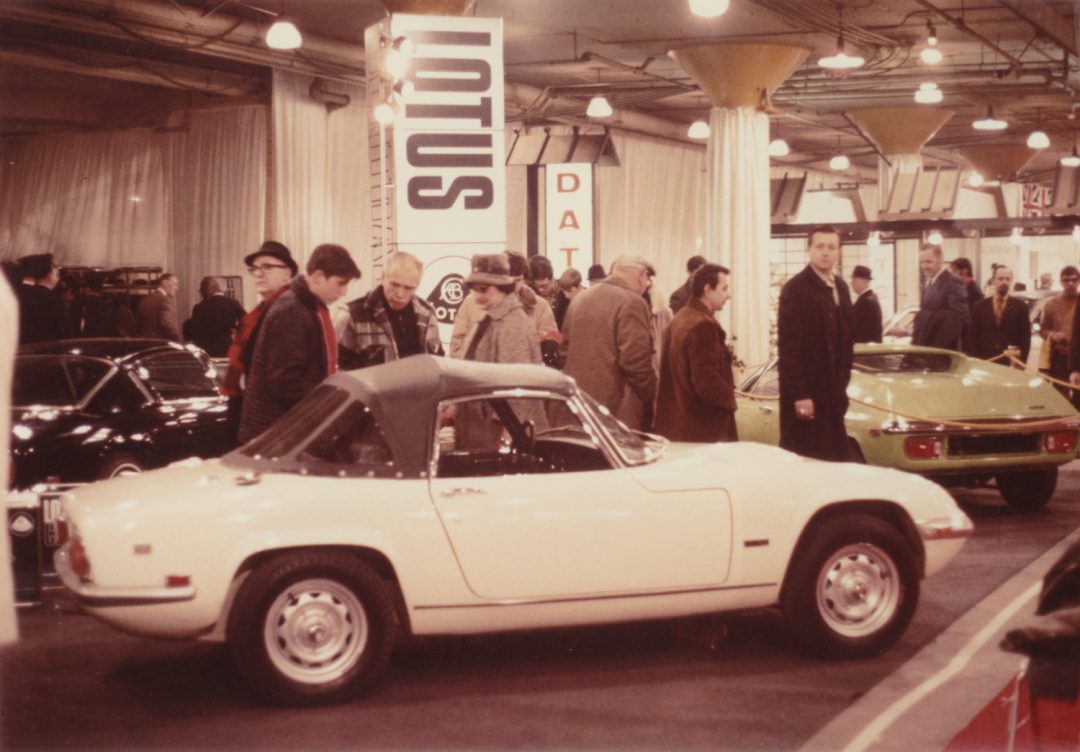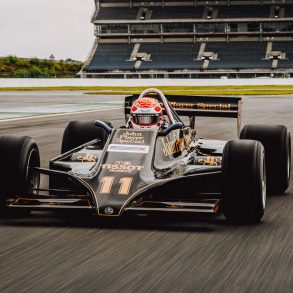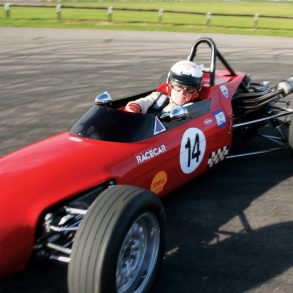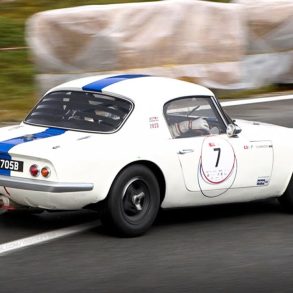In May 1968, my former wife and I traveled by train, ferry and again by train from Pirmasens, Germany, to Norwich, England. Our purpose was to pick up our new 1968 Lotus Europa at the factory in Wymondham, near Norwich. We had a few adventures along the way, thanks to a train crash in Germany before we got on, that turned an 18-hour trip into a 36-hour one. We were quite happy to finally find a bed and breakfast in Norwich. The owners were wonderful and even called the Lotus factory to announce our arrival. The next day, a car was sent to take us to the factory to see our Europa in the last stages of its build. That car was a red Lotus Elan +2. I had never heard of, or seen, a +2, and I wondered if it was too late to exchange our Europa for one of those sleek beauties – it was. For nearly 50 years, the thought of that car remained lurking in my brain. As I aged, I wondered if I could get in and out of one. In April 2017, I found out, thanks to the excellent forums on the Lotus Ltd. Club website. I posted that I wanted to do an article on a +2 and found two nice ones in Colorado – one original and the other upgraded to a Zetec engine and Spyder chassis.

The Type 50, or Lotus +2 as it was called in factory brochures, had a run from 1967 to late 1974. Nearly 5,200 were produced during that time. It was the first pure Lotus to have more than two seats, and it was the first Lotus without a kit version being offered. It was predated by the Lotus Cortina, but that was a Ford saloon modified by Lotus. The +2 was to be a “family” car, with seats for two children in the back, or in our case, one 5’6” woman sitting cross-wise. The +2 had a chassis that was 1-foot longer, track 7-inches wider, and overall length 23-inches more than the Elan. It had the same engine, comparable suspension and a similar, albeit longer, steel backbone chassis as the Elan. It was also 315 pounds heavier, but the effect on performance wasn’t nearly as bad as it might have been because the car was much more aerodynamic (Cd=0.30) than its smaller sister. Carburetion was initially by twin Webers and then by twin Dellortos at the end of production, although the U.S. federalized versions used Strombergs.

As their “family” car gained in sales, the factory began emphasizing comfort and luxury over performance when the +2S came out in 1969. Still, they didn’t forget performance, because later that year they began putting the Lotus Big Valve engine in the cars. By 1971, all the +2S 130 models had the big valve engines with a 25% increase in power over the original engine. These cars are usually recognized by their metallic silver roofs, although a solid color car could be special ordered. A late addition was a 5-speed, overdrive transmission introduced in October 1972.

1969 Lotus Elan +2
I had plans to profile several cars in New Mexico and Colorado, so I added the +2s to my trip. First stop was to meet Jeff Krueger in Sedalia, Colorado, and experience his original Elan +2. It seems that most Lotus owners, have owned a series of cars of the marque. Krueger had an Esprit and Seven clones until he found the +2. He has two kids—seven and eight-years old—so the +2 was a perfect Lotus for his family. His car is a stock 1969 with all original Lotus components. It is a very nice car, but Krueger is in the process of building an improved version of the +2, much like the car I was able to experience a day later.
Thanks to Krueger, I was able to determine that I can enter and exit a +2 with relative ease….and what a joy to drive. The car started easily and we were off. It has excellent gauges, and the seats are very comfortable. Steering wheel and shifter fall right to hand. Big feet can be a problem in any Lotus, so even with a larger car one must be careful not to cover the gas and brake pedals at the same time.
Krueger lives in a valley, with mountains only a couple miles away, so the test drive included an excellent mountain road with curves of all sorts and steep climbs and descents – a great road to try out a Lotus. A friend, David Allin, who has driven my “camera car” for me on a number of occasions, was with me for the ride. We chatted as I drove the car up grades and through corners. At one point, while talking about the car’s incredibly flat cornering, I tried to sum up its handling with, “What can I say? It’s a Lotus!” It was that good! The only downside was that there are a lot of revs lost when shifting between 2ndand 3rd. This combined with a lack of torque from the engine at lower revs meant a lot of stirring of the shifter on some of the uphill stretches. I’ve long had “Lotus Lust” deep in my heart, and this drive brought it to the surface.
1972 Lotus Elan +2 Zetec
Next stop was Colorado Springs, where Ross Robbins has what may be a very unique +2 for the U.S. Robbins has had 13 Lotus cars of various types. He was bitten by Lotus Lust when he sold several cars, including his Sprite racecar and his big Healey to buy an Elan racecar. Robbins drives his cars. He has bought a number of Lotus cars online, flown to get them and driven them home. He drove his first +2 from New York, a Europa from Wisconsin, and an M100 from Washington, for example. He’s even written a book about his road trips, available as a trade paperback on Amazon. His desire to drive his Lotus everywhere led him to call a fellow he met at a Lotus Owners Gathering in Orlando. The car was a modified +2 with a chassis built by Spyder in England, a fuel-injected Zetec engine and a 5-speed transmission. The owner had decided to sell the +2 only two days before Robbins called. The deal they reached was more than Robbins had expected—he got the +2, but he also had to take a rolling chassis, a stripped chassis, a Spyder chassis, and boxes and boxes of parts. The car he wanted without all the extras would cost $5000 more than if he took it all. Getting all that back to Colorado is an adventure story best heard in person.
When asked why the Zetec car, Robbins replies that “Ann (his wife) and I love to travel, almost all summer, so we wanted a car with air conditioning. This car has the a/c ducts nicely integrated into the dash, has an XM radio, and five-speed transmission that allows us to cruise at 75 at 3100 rpm – and you can hear the radio! It’s nice to be able to cruise when crossing the country.” He added that it, “drives like a Lotus, but it’s a version for a mature driver.”
The Zetec gives 160 hp and has a lot more torque, which comes in early, where the stock Lotus doesn’t get on its torque curve until about 3500 rpm. All Robbins’ comments became real when I got the chance to drive the car. We took it on the highway and on wonderfully curving roads. The extra power was great on the hills and for merging with traffic on the highway. The gears were very comfortably spaced, and few revs were lost when shifting, while going uphill. Together with the torque of the Zetec, this car is a much better driver than the original. It does everything an original +2 does, only better. It truly is an improved car.
So, after driving both these cars, which do I prefer? I have to say that I loved them both, and they have really gotten my Lotus Lust beating hard in my breast. The Zetec +2 is the better car, but if Krueger decides to sell his original when he gets his Zetec done, I am very interested. Oh my, yes I am.
Many thanks to Krueger and Robbins for allowing me to drive their cars. They are two fine guys who have a couple of wonderful cars.
https://www.youtube.com/watch?v=VKapn0s7UDg
Original Specifications
| Body | Fiberglass 2+2 |
| Chassis | Steel backbone |
| Engine | Lotus-Ford DOHC |
| Displacement | 1558-cc/85.075 cid |
| Power | 118 bhp |
| Torque | 108 ft-lbs at 4000 rpm |
| Transmission | 4-speed, all synchro |
| Length | 169 inches/429.26 cm |
| Width | 66 inches/167.64 cm |
| Height | 47 inches/119.38 cm |
| Wheelbase | 96 inches/243.84 cm |
| Weight | 1880 lbs/853 kg |
| Top Speed | 118 mph, 190 kph |
| 0-60 mph | 8.9 sec |
| 0-100 mph | 24.2 sec |
| Fuel Consumption | 19.7 mpg, average |



















